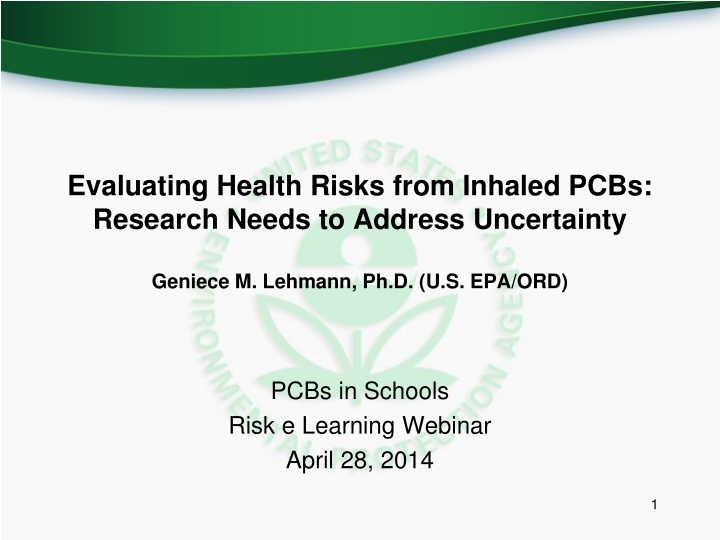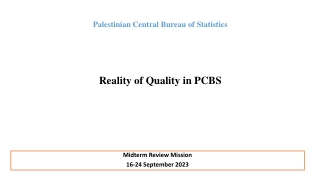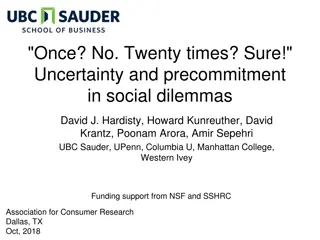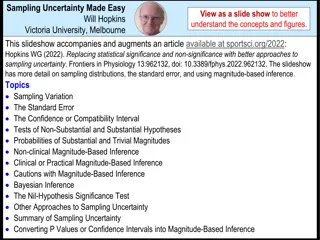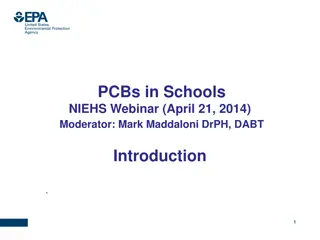Evaluating Health Risks from Inhaled PCBs: Research Needs to Address Uncertainty
This informative content discusses the history of PCB use in the U.S., human health risks associated with inhaled PCBs, uncertainties in risk assessment, and research needs to address these uncertainties. It also explores the presence of PCBs in indoor air, potential health risks posed by PCBs, and how to assess human health hazards from PCB exposure. The content touches on observed health effects of PCB exposure in both humans and animals, including cancer, hepatotoxicity, and thyroid effects.
Uploaded on Feb 18, 2025 | 2 Views
Download Presentation

Please find below an Image/Link to download the presentation.
The content on the website is provided AS IS for your information and personal use only. It may not be sold, licensed, or shared on other websites without obtaining consent from the author.If you encounter any issues during the download, it is possible that the publisher has removed the file from their server.
You are allowed to download the files provided on this website for personal or commercial use, subject to the condition that they are used lawfully. All files are the property of their respective owners.
The content on the website is provided AS IS for your information and personal use only. It may not be sold, licensed, or shared on other websites without obtaining consent from the author.
E N D
Presentation Transcript
Evaluating Health Risks from Inhaled PCBs: Research Needs to Address Uncertainty Geniece M. Lehmann, Ph.D. (U.S. EPA/ORD) PCBs in Schools Risk e Learning Webinar April 28, 2014 1
Overview History of U.S. interest in health risks of PCB inhalation Human health risk assessment of inhaled PCBs Hazard identification Dose-response assessment Uncertainties Research needs The views expressed here are those of the authors and do not necessarily reflect the views or policies of the U.S. EPA. U.S. Environmental Protection Agency 2
History of PCB use in U.S. Manufactured from 1929 to 1977 Peak production in 1970 (85,000,000 lbs) Uses: Dielectric fluid in transformers Oil used in motors and hydraulic systems Electrical devices/appliances containing PCB capacitors Fluorescent light ballast capacitors** Adhesives and tapes Oil-based paints Plasticizer in caulk and window glazing** Carbonless copy paper Floor finish Ceiling tiles* Microscope oil *Has been found in school buildings **Commonly found in school buildings built 1950s 1970s 3
PCBs in indoor air Herrick et al. (2004). "An unrecognized source of PCB contamination in schools and other buildings." Environmental Health Perspectives 112(10): 1051-1053. 24 buildings in Boston, Massachusetts area Samples of exterior caulk 8 buildings contained caulk with PCBs > 50 ppm Caulk taken from a university student housing building contained 36,200 ppm PCB MacIntosh et al. (2012). Mitigation of building-related polychlorinated biphenyls in indoor air of a school. Environmental Health 11: 24-33. One elementary school in Massachusetts with PCB- containing caulk (range 1,830 29,400 ppm PCB) Mean indoor air PCB concentration > 500 ng/m3 Similar indoor air PCB concentrations have been reported for other buildings constructed with PCB-containing caulk Kohler et al. (2005). Joint sealants: An overlooked diffuse source of polychlorinated biphenyls in buildings. Environmental Science and Technology 39(7): 1967-1973. 4
How Can We Assess Human Health Hazard from Inhaled PCBs? 6
Health Effects of PCB Exposure Observed in humans (exposed by multiple routes) Observed in animals (exposed by ingestion) Observed in animals (exposed by inhalation) Cancer (melanoma, non- Hodgkin lymphoma, breast cancer) Cancer Hepatotoxicity Hepatotoxicity Thyroid effects Thyroid effects Immunotoxicity Thyroid effects Immunotoxicity Neurotoxicity Immunotoxicity Reproductive effects Reproductive effects Developmental neurobehavioral toxicity Developmental neurobehavioral toxicity 7
Health Effects of PCB Exposure Observed in humans (exposed by multiple routes) Observed in animals (exposed by ingestion) Observed in animals (exposed by inhalation) Cancer (melanoma, non- Hodgkin lymphoma, breast cancer) Cancer Hepatotoxicity Hepatotoxicity Thyroid effects Thyroid effects Immunotoxicity Thyroid effects Immunotoxicity Neurotoxicity Immunotoxicity Reproductive effects Reproductive effects Developmental neurobehavioral toxicity Developmental neurobehavioral toxicity 8
Health Effects of PCB Exposure Observed in humans (exposed by multiple routes) Observed in animals (exposed by ingestion) Observed in animals (exposed by inhalation) Cancer (melanoma, non- Hodgkin lymphoma, breast cancer) Cancer Hepatotoxicity Hepatotoxicity Thyroid effects Thyroid effects Immunotoxicity Thyroid effects Immunotoxicity Neurotoxicity Immunotoxicity Reproductive effects Reproductive effects Developmental neurobehavioral toxicity Developmental neurobehavioral toxicity 9
Health Effects of PCB Exposure Observed in humans (exposed by multiple routes) Observed in animals (exposed by ingestion) Observed in animals (exposed by inhalation) Cancer (melanoma, non- Hodgkin lymphoma, breast cancer) Cancer Hepatotoxicity (1) Hepatotoxicity (~40) Thyroid effects (1) Thyroid effects (~40) Immunotoxicity (1) Thyroid effects Immunotoxicity (~40) Neurotoxicity (1) Immunotoxicity Reproductive effects (~40) Reproductive effects Developmental neurobehavioral toxicity (~30) Developmental neurobehavioral toxicity 10
PCB Inhalation Data - Animals Treon et al. (1956). "The toxicity of the vapors of Aroclor 1242 and Aroclor 1254." American Industrial Hygiene Association Quarterly 17(2): 204-213. Study Design Cats (n = 1), rabbits (n = 4), guinea pigs (n = 6), rats (n = 10) and mice (n = 10) exposed 7 hours/day, 5 days/week for 213 days 1.5 mg/m3 Aroclor 1254 Hepatotoxicity Caveats Single PCB dose tested Some study animals died for reasons unrelated to treatment Uncertain exposure characterization 11
PCB Inhalation Data - Animals Casey et al. (1999). "Aroclor 1242 inhalation and ingestion by Sprague-Dawley rats." Journal of Toxicology and Environmental Health, Part A: Current Issues 56(5): 311-342. Study Design Rats exposed 23 hours/day for 30 days (n = 8) 0.0009 mg/m3 Aroclor 1242 histopathological changes in the thyroid, thymus, and urinary bladder increased serum thyroid hormone concentrations neurobehavioral changes Caveats Single PCB dose tested Whole-body exposure Incomplete exposure information 12
PCB Inhalation Data - Animals Hu et al. (2012). Subchronic inhalation exposure study of an airborne polychlorinated biphenyl mixture resembling the Chicago ambient air congener profile." Environmental Science and Technology 46: 9653-9662. Study Design Rats exposed 1.6 hours/day, 5 days/week for 4 weeks (n = 12) 0.52 mg/m3 PCBs Investigated: pulmonary immune responses; histopathology (liver, lung, thymus, spleen, kidney, and thyroid); cytochrome P450 enzyme induction (liver and lung); redox status of glutathione (serum, liver and lung); and hematological parameters Observed: a shift to more oxidized glutathione in serum and elevated hematocrit Caveats Single PCB dose tested Short exposure duration 13
PCB Inhalation Data Animals (Rats) Treon et al. (1956) 7 hours/day 5 days/week 213 days 1.5 mg/m3 Casey et al. (1999) 23 hours/day 7 days/week 30 days 0.0009 mg/m3 Hu et al. (2012) 1.6 hours/day 5 days/week 28 days 0.52 mg/m3 Exposure Duration Dose (Aroclor 1254) (Aroclor 1242) (PCBs to mimic Chicago air) Minimal toxicity Hepatotoxicity Thyroid effects Immunotoxicity Neurotoxicity Whole body exposure Effects Observed Whole body exposure Nose-only exposure Notes on Exposure Uncertain exposure assessment Uncertain exposure assessment 14
What Research Would Reduce Uncertainty? Accurate Exposure Assessment What is the congener profile of the PCB mixture? Comprehensive Health Effect Evaluation Developmental neurotoxicity Immunotoxicity Changes in thyroid hormone levels 16
What Research Would Reduce Uncertainty? Well-characterized inhalation exposure - Based on measurements of PCBs in air or on measures of PCB body burden? PCBs in air Reflect inhalation exposure at a given time PCB body burden Reflects accumulated exposure over time and across all exposure routes RESEARCH NEED: PBPK models describing the kinetic properties of inhaled PCBs (and possibly dermal absorption of airborne congeners) Epidemiology 17
What Research Would Reduce Uncertainty? Well-characterized inhalation exposure - Based on measurements of PCBs in air; do not rely solely on measures of PCB body burden Key health effects measured - Serum thyroid hormone levels (e.g., tT4 and TSH) - Susceptibility to infection or antibody responses to immunization - Neurodevelopmental effects in children Epidemiology 18 Airborne PCBs
What Research Would Reduce Uncertainty? Studies with monkeys or rats Chronic & developmental exposure - Chronic = 42 months (monkeys); 24 months (rats) - Developmental study Exposed to at least 2 PCB concentrations, preferably 3 or more Dose response information Exposed by whole-body or nose-only? Animal Studies - Whole-body Potential for confounding oral exposure Nose-only Stress may confound results Limited daily exposure duration Limited animal number 19
What Research Would Reduce Uncertainty? Studies with monkeys or rats Chronic & developmental exposure - Chronic = 42 months (monkeys); 24 months (rats) - Developmental study Exposed to at least 2 PCB concentrations, preferably 3 or more Dose response information Exposed by whole-body or nose-only? Animal Studies - Measure health outcomes - Developmental neurobehavioral effects (e.g., response inhibition) - Immunotoxicity (e.g., antibody responses in monkeys or NK cell activity in rats) - Changes in thyroid hormone levels (e.g., decreased tT4 and increased TSH) 20
Additional Factors to Consider Congener composition of the PCB mixture administered in animal studies IMPACTS: 1. 2. Physicochemical properties Toxicity 21
Lower- chlorinated congeners tend to be more volatile Higher-chlorinated congeners tend to be resistant to metabolism & bioconcentrate in the food chain
Health effects of oral PCB exposure*: Higher-chlorinated PCB congeners Lower-chlorinated PCB congeners Hepatotoxicity Thyroid effects Dioxin-like congeners PCB 77 PCB 81 PCB 105 PCB 114 PCB 118 PCB 123 PCB 126 PCB 156 PCB 157 PCB 167 PCB 169 PCB 189 Immunotoxicity Neurotoxicity 23 *observed in animal studies
Additional Factors to Consider Congener composition of the PCB mixture administered in animal studies Which available mixtures, when volatilized, will yield a congener profile most similar to a typical human inhalation exposure? PCB Congener Profiles in Outdoor Air 100 90 Percentage of Congener Mixture 80 70 60 50 a Chicago, IL b 40 Rice Creek, NY 30 20 10 0 1 2 3 4 5 6 7 8 9 10 24 Number of Chlorines Per Congener a Simcik et al. 1998. Environ Sci Technol 32: 251-257. b Chiarenzelli et al. 2001. Environ Sci Technol 35: 3280-3286.
Additional Factors to Consider Congener composition of the PCB mixture administered in animal studies Which available mixtures, when volatilized, will yield a congener profile most similar to a typical human inhalation exposure? 25 Heinzow B et al. 2007. Chemosphere 67: 1746-1753.
Additional Factors to Consider Congener composition of the PCB mixture administered in animal studies RESEARCH NEEDS: 1. Individual PCB congener analyses of indoor and outdoor air in a variety of human exposure contexts to better characterize the range of relevant inhalation mixtures and the congeners present Toxicological data from a number of different mixtures spanning the range observed in human exposure contexts 2. 26
Additional Factors to Consider Toxicological endpoints unique to inhalation exposure CONSEQUENCES OF ORAL AND INHALATION EXPOSURES MAY DIFFER: 1. There may be congeners present in air that are not typically found in the diet. 2. There may also be differences in tissue distribution or metabolism between the inhalation and oral routes of exposure. 27
Additional Factors to Consider Toxicological endpoints unique to inhalation exposure RESEARCH NEEDS: 1. Epidemiological and toxicological studies of PCB inhalation that investigate health endpoints other than those previously shown to be associated with oral PCB exposure 28
Research to Reduce Uncertainty Human or animal studies: Subjects exposed to PCBs by inhalation PCB exposure well-characterized Studies of chronic or developmental exposures in monkeys or rats Animal studies testing 2 PCB concentrations (preferably 3) Candidate health outcomes - Developmental neurobehavioral effects on executive function - Immune suppression - Decreased serum tT4 and increased serum TSH PBPK models describing the kinetic properties of airborne PCBs Individual PCB congener analyses of indoor and outdoor air Contact Information Geniece Lehmann +1-919-541-2289 lehmann.geniece@epa.gov 29
